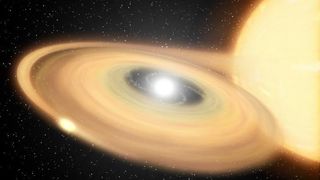'Cataclysmic' 50-minute orbit between two stars is the fastest ever recorded
These could be the fastest-orbiting stars ever seen.

Can a pair of stars have a toxic relationship? Consider this as you get to know the newly discovered star system ZTF J1813+4251, a tight-knit stellar couple with such tyrannical control over one another that they complete a full orbit of each other once every 51 minutes — the shortest orbit detected in any binary star system to date, according to research published today (Oct. 5) in the journal Nature.
Astronomers discovered the clingy star system about 3,000 light-years from the sun, in the constellation Hercules, while combing through a database of more than 1 billion stars. There, a bright sun-like star with roughly the same mass as Jupiter lives out its last healthy years in the company of a white dwarf — the shriveled husk of a once-mighty star that is, technically, already dead and done burning fuel. But, from beyond the stellar grave, the white dwarf's gravity continues to suck hydrogen out of the sun-like star's atmosphere, slowly diminishing the larger star and accelerating its inevitable doom.
This is not unusual in astronomy; more than 50% of all stars in the Milky Way are binary pairs of two or more stars, sharing a mutual center of gravity while robbing each other of precious fuel. However, astronomers have discovered few binary star systems with orbital periods shorter than an hour — especially systems including large, sun-like stars, which take many hours to complete a single orbit. When astronomers saw the two stars in Hercules eclipsing each other's light every 51 minutes, they knew they'd stumbled upon something strange.
"This one star looked like the sun, but the sun can't fit into an orbit shorter than eight hours — what's up here?" lead study author Kevin Burdge, a physicist at MIT, said in a statement.
In their new paper, the researchers give that strangeness a name. According to the study authors, these stars belong to a rare class of binary star system called a "cataclysmic variable." These systems occur when a white dwarf and a sun-like star draw closer and closer together over billions of years, allowing the white dwarf to gobble up material from its companion. As the dwarf star feasts, it can trigger enormous flares of light that appear, from a distance, like supernova explosions or some other type of cosmic cataclysm, the authors said.
Researchers have long suspected that stars like these are capable of reaching incredibly short orbital periods if given enough time. This is only possible if the star system transitions to a new diet, so to speak; once the hungry white dwarf finishes stripping the hydrogen from its companion star's atmosphere, it begins devouring helium from the companion star's exposed core. Because helium is denser and heavier than hydrogen, the core of the sun-like star should be sufficiently massive to remain in a super-tight binary orbit with its white dwarf companion.
According to the study authors, this oddball star system in Hercules appears to be in the midst of just such a transition — and the system's orbital period should only get tighter and shorter. Using computer simulations, the team calculated that, in roughly 70 million years, the two stars will draw so close to each other that their orbit will drop down to just 18 minutes — far shorter than any star system ever seen.
Sign up for the Live Science daily newsletter now
Get the world’s most fascinating discoveries delivered straight to your inbox.
From there, mass loss will cause the sun-like star to expand rather than contract, and the two stars will finally start to drift apart for the next several hundred million years, the team said. At that point, the couple's orbital period will settle into a groove of roughly 30 minutes, giving the binary pair some much-needed space in their final years together before the larger star burns out.
While this sort of binary relationship has been theorized to exist, this new research marks the first time that it has been seen in action, according to the study authors. This answers a "big open question" about the orbital limits of cataclysmic variable star systems, Burdge said, and should provide plenty of fodder for further study in the years to come.
As to whether the larger star is in a toxic relationship? Perhaps it's best to ask again in a few hundred million years.

Brandon is the space/physics editor at Live Science. His writing has appeared in The Washington Post, Reader's Digest, CBS.com, the Richard Dawkins Foundation website and other outlets. He holds a bachelor's degree in creative writing from the University of Arizona, with minors in journalism and media arts. He enjoys writing most about space, geoscience and the mysteries of the universe.
Most Popular



